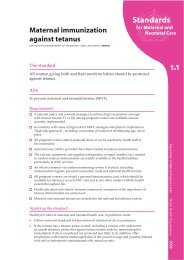1uvZ4zN
1uvZ4zN
1uvZ4zN
Create successful ePaper yourself
Turn your PDF publications into a flip-book with our unique Google optimized e-Paper software.
Volume III<br />
Chapter ONE<br />
activities. What would happen with the emergence of the colonial situation Towards the<br />
end of 19 th Century particularly after the consolidation of British authority around the time<br />
of World War I, what the British did which contributed to the emergence of consciousness<br />
of various ethnic groups was the idea of containment. Before colonialism, people were<br />
moving freely depending on their ability to conquer; but with colonialism, they were now<br />
confined to a territory. Administrative units were created and there was an association of<br />
people within an area. Over the years, a sense of feeling that “this is our area” or “this is<br />
our territory” or “this is our land” developed. Hence, the emergence of Nandi district, Kisii<br />
district, Kiambu district and so on. So, you are there because of colonial convenience but<br />
over the years, a consciousness of ownership of that particular asset called land began to<br />
emerge. Therefore, you begin to see the convergence of territory and ethnic groups. The<br />
association of certain ethnic groups emerged. For example, Central province belonged to<br />
Kikuyu, Nyanza for the Luos and Kisii, Western for Luhyas, Rift Valley for KAMATUSA; that is,<br />
Kalenjin, Maasai, Turkana and Samburu. 16 “<br />
26. As a result of the ethnic biases that coloured development and land policies<br />
of the colonial government, Kenya, like many other African countries, entered<br />
the era of independence with a heightened sense of ethnicity that continued<br />
to divide rather than unite the country. This ethnocentrism had manifold<br />
implications. It encouraged the politicisation and manipulation of ethnic<br />
identities, resulting in the exclusion of some communities from participating<br />
fully in the core social, economic and political activities of the country. 17<br />
Consequently, one of the most acute problems the country faces is the endless<br />
struggle to integrate its different communities into a democratic modern nation,<br />
without compromising their respective ethnic identities. 18<br />
27. The multiple contradictions left behind by colonial policies on the one hand, and<br />
the lack of political will and commitment on the part of the ruling political elite<br />
continued to impact negatively on all efforts at creating a truly democratic and<br />
prosperous Kenya for all its citizens.<br />
Insider/Outsider dynamics<br />
28. Related to the colonial origins of ethnic tensions discussed above is the phenomenon<br />
of ‘insiders’ and ‘outsiders’. Ethnic tension and violence occur when communities<br />
assert a superior claim over a territory at the expense of or to the exclusion of<br />
others. Such superior claims are based on the assumption that ownership or<br />
occupation at some point in the past created an exclusive claim for such ownership<br />
or occupation in the present. Often such claims are based on a selective reading of<br />
history or oral tradition and myths handed down from generation to generation.<br />
16. TJRC/Hansard/Thematic Hearing on Ethnic Tension and Violence/Nairobi/2 February 2012/p. 5<br />
17 African Peer Review Mechanism (n 8 above) 49.<br />
18 As above.<br />
REPORT OF THE TRUTH, JUSTICE AND RECONCILIATION COMMISSION<br />
9






